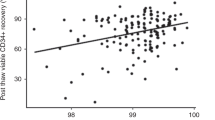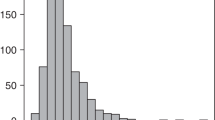Abstract
Stem cell doses necessary for engraftment after myelo-ablative therapy as defined for fresh transplants vary largely. Loss of CD34+ cell quality after cryopreservation might contribute to this variation. With a new early apoptosis assay including the vital stain Syto16, together with the permeability marker 7-AAD, CD34+ cell viability in leucapheresis samples of 49 lymphoma patients receiving a BEAM regimen was analysed. After freeze–thawing large numbers of non-viable, early apoptotic cells appeared, leading to only 42% viability compared to 72% using 7-AAD only. Based on this Syto16 staining in the frozen–thawed grafts, threshold numbers for adequate haematological recovery of 2.8–3.0 × 106 CD34+ cells/kg body weight determined for fresh grafts, now decreased to 1.2–1.3 × 106 CD34+ cells/kg. In whole blood transplantation of lymphoma patients (n = 45) receiving a BEAM-like regimen, low doses of CD34+ cells were sufficient for recovery (0.3–0.4 × 106CD34+ cells/kg). In contrast to freeze–thawing of leucapheresis material, a high viability of CD34+ cells was preserved during storage for 3 days at 4°C, leaving threshold doses for recovery unchanged. In conclusion, the Syto16 assay reveals the presence of many more non-functional stem cells in frozen–thawed transplants than presumed thus far. This led to a factor 2.3-fold adjustment downward of viable CD34+ threshold doses for haematological recovery.
Bone Marrow Transplantation (2002) 29, 249–255. doi:10.1038/sj.bmt.1703357
This is a preview of subscription content, access via your institution
Access options
Subscribe to this journal
Receive 12 print issues and online access
$259.00 per year
only $21.58 per issue
Buy this article
- Purchase on Springer Link
- Instant access to full article PDF
Prices may be subject to local taxes which are calculated during checkout





Similar content being viewed by others
References
Filip S, Blaha M, Odrazka K et al. Application of whole blood and peripheral blood progenitor cells (PBPC) and new strategies for rescue after intensive cyclic chemotherapy in high-risk breast cancer J Hematother Stem Cell Res 2000 9: 31 38
Vanasek J, Filip S, Medkova V et al. Mobilization of peripheral blood progenitor cells (PBPC) through a combination of chemotherapy and G-CSF in breast cancer patients and a possibility of unprocessed whole blood collection Bone Marrow Transplant 1998 21: 123 126
Stewart DA, Guo D, Gluck S et al. Double high-dose therapy for Hodgkin's disease with dose-intensive cyclophosphamide, etoposide, and cisplatin (DICEP) prior to high-dose melphalan and autologous stem cell transplantation Bone Marrow Transplant 2000 26: 383 388
Stewart DA, Guo D, Luider J et al. Factors predicting engraftment of autologous blood stem cells: CD34+ subsets inferior to the total CD34+ cell dose Bone Marrow Transplant 1999 23: 1237 1243
Hohaus S, Martin S, Schneeweiss A et al. Adjuvant high-dose therapy with peripheral blood stem cell support for patients with high-risk breast cancer Cancer Chemother Pharmacol 1999 44: (Suppl.) S13 S17
Ketterer N, Sonet A, Dumontet C et al. Toxicities after peripheral blood progenitor cell transplantation for lymphoid malignancies: analysis of 300 cases in a single institution Bone Marrow Transplant 1999 23: 1309 1315
Alessandrino P, Bernasconi P, Caldera D et al. Adverse events occurring during bone marrow or peripheral blood progenitor cell infusion: analysis of 126 cases Bone Marrow Transplant 1999 23: 533 537
Ossenkoppele GJ, Schuurhuis GJ, Jonkhoff AR et al. High-dose melphalan with re-infusion of unprocessed, G-CSF-primed whole blood is effective and non-toxic therapy in multiple myeloma Eur J Cancer 1996 32A: 2058 2063
Woll PJ, Thatcher N, Lomax L et al. Use of hematopoietic progenitors in whole blood to support dose-dense chemotherapy: a randomized phase II trial in small-cell lung cancer patients J Clin Oncol 2001 19: 712 719
Ibrahim A, Fadel E, Jisr T et al. Autotransplantation for relapsed, refractory or high risk lymphoma with non cryopreserved hematopoietic peripheral stem cells Blood 1999 94: 4738 (Abstr.)
Ossenkoppele GJ, Schuurhuis GJ, Jonkhoff AR et al. G-CSF (filgrastim)-stimulated whole blood kept unprocessed at 4°C does support a BEAM-like regimen in bad-risk lymphoma Bone Marrow Transplant 1996 18: 427 431
Pettengell R, Morgenstern GR, Woll PJ et al. Peripheral blood progenitor cell transplantation in lymphoma and leukemia using a single apheresis Blood 1993 82: 3770 3777
Weaver A, Chang J, Wrigley E et al. Randomized comparison of progenitor-cell mobilization using chemotherapy, stem-cell factor, and filgrastim or chemotherapy plus filgrastim alone in patients with ovarian cancer J Clin Oncol 1998 16: 2601 2612
Ruiz-Arguelles GJ, Lobato-Mendizabal E, Ruiz-Arguelles A et al. Non-cryopreserved unmanipulated hematopoietic peripheral blood stem cell autotransplant program: long-term results Arch Med Res 1999 30: 380 384
Ruiz-Arguelles GJ, Ruiz-Arguelles A, Perez-Romano B et al. Filgrastim-mobilized peripheral-blood stem cells can be stored at 4 degrees and used in autografts to rescue high-dose chemotherapy Am J Hematol 1995 48: 100 103
Bezwoda WR, Dansey R, Seymour L, Glencross D . Non-cryopreserved, limited number (1 or 2) peripheral bloodprogenitor cell (PBPC) collections following GCSF administration provide adequate hematologic support for high dose chemotherapy Hematol Oncol 1994 12: 101 10
Shpall EJ, Champlin R, Glaspy JA . Effect of CD34+ peripheral blood progenitor cell dose on hematopoietic recovery Biol Blood Marrow Transplant 1998 4: 84 92
Dercksen MW, Gerritsen WR, Rodenhuis S et al. Expression of adhesion molecules on CD34+ cells: CD34+ L-selectin+ cells predict a rapid platelet recovery after peripheral blood stem cell transplantation Blood 1995 85: 3313 3319
Siena S, Schiavo R, Pedrazzoli P, Carlo-Stella C . Therapeutic relevance of CD34 cell dose in blood cell transplantation for cancer therapy J Clin Oncol 2000 18: 1360 1377
Perez-Simon JA, Caballero MD, Corral M et al. Minimal number of circulating CD34+ cells to ensure successful leukapheresis and engraftment in autologous peripheral blood progenitor cell transplantation Transfusion 1998 38: 385 391
Geisler CH, Hansen MM, Andersen NS et al. BEAM + autologous stem cell transplantation in malignant lymphoma: 100 consecutive transplants in a single centre. Efficacy, toxicity and engraftment in relation to stem-cell source and previous treatment Eur J Haematol 1998 61: 173 182
Schuurhuis GJ, Muijen MM, Oberink JW et al. Large populations of non-clonogenic early apoptotic CD34-positive cells are present in frozen–thawed peripheral blood stem cell transplants Bone Marrow Transplant 2001 27: 487 498
Sutherland DR, Anderson L, Keeney M et al. The ISHAGE guidelines for CD34+ cell determination by flow cytometry. International Society of Hematotherapy and Graft Engineering J Hematother 1996 5: 213 226
Pettengell R, Woll PJ, O'Connor DA et al. Viability of haemopoietic progenitors from whole blood, bone marrow and leukapheresis product: effects of storage media, temperature and time Bone Marrow Transplant 1994 14: 703 709
Haas R, Witt B, Mohle R et al. Sustained long-term hematopoiesis after myeloablative therapy with peripheral blood progenitor cell support Blood 1995 85: 3754 3761
Jones N, Williams D, Broadbent V et al. High-dose melphalan followed by autograft employing non-cryopreserved peripheral blood progenitor cells in children Eur J Cancer 1996 32A: 1938 1942
Jones K, Tucker D, Fryga A . Peripheral blood stem cell transplantation-what do we infuse? Cytotherapy 2000 2: (Abstr.)
Schmid I, Ferbas J, Uittenbogaart CH, Giorgi JV . Flow cytometric analysis of live cell proliferation and phenotype in populations with low viability Cytometry 1999 35: 64 74
Anthony RS, McKelvie ND, Cunningham AJ et al. Flow cytometry using annexin V can detect early apoptosis in peripheral blood stem cell harvests from patients with leukaemia and lymphoma Bone Marrow Transplant 1998 21: 441 446
Lazarus HM, Pecora AL, Shea TC et al. CD34+ selection of hematopoietic blood cell collections and autotransplantation in lymphoma: overnight storage of cells at 4°C does not affect outcome Bone Marrow Transplant 2000 25: 559 566
Hechler G, Weide R, Heymanns J et al. Storage of noncryopreserved periphered blood stem cells for transplantation Ann Hematol 1996 72: 303 306
Watanabe T, Dave B, Heimann DG et al. GM-CSF-mobilized peripheral blood CD34+ cells differ from steady-state bone marrow CD34+ cells in adhesion molecule expression Bone Marrow Transplant 1997 19: 1175 1181
Acknowledgements
The authors thank Ria van Wijngaarden-Du Bois and Kirsten Huijboom from the Central Laboratory Bloedtransfusiedienst Amsterdam for providing part of the leucapheresis samples of lymphoma patients, Arne de Kreuk for critically reading the manuscript and Cinthy Dekker-van Roessel for help with recovery data.
Author information
Authors and Affiliations
Rights and permissions
About this article
Cite this article
de Boer, F., Dräger, A., Pinedo, H. et al. Extensive early apoptosis in frozen–thawed CD34-positive stem cells decreases threshold doses for haematological recovery after autologous peripheral blood progenitor cell transplantation. Bone Marrow Transplant 29, 249–255 (2002). https://doi.org/10.1038/sj.bmt.1703357
Received:
Accepted:
Published:
Issue Date:
DOI: https://doi.org/10.1038/sj.bmt.1703357
Keywords
This article is cited by
-
Best practices for cryopreserving, thawing, recovering, and assessing cells
In Vitro Cellular & Developmental Biology - Animal (2017)
-
Human Wharton’s Jelly Stem Cell Conditioned Medium Enhances Freeze-Thaw Survival and Expansion of Cryopreserved CD34+ Cells
Stem Cell Reviews and Reports (2013)
-
Recovery, viability and clinical toxicity of thawed and washed haematopoietic progenitor cells: analysis of 952 autologous peripheral blood stem cell transplantations
Bone Marrow Transplantation (2007)
-
Apoptotic lymphocytes and CD34+ cells in cryopreserved cord blood detected by the fluorescent vital dye SYTO 16 and correlation with loss of L-selectin (CD62L) expression
Bone Marrow Transplantation (2006)
-
Recovery of viable CD34+ cells from cryopreserved hemopoietic progenitor cell products
Bone Marrow Transplantation (2005)



